Related Research Articles

Electronic paper or intelligent paper, is a display device that mimics the appearance of ordinary ink on paper. Unlike conventional flat panel displays that emit light, an electronic paper display reflects ambient light, like paper. This may make them more comfortable to read, and provide a wider viewing angle than most light-emitting displays. The contrast ratio in electronic displays available as of 2008 approaches newspaper, and newly developed displays are slightly better. An ideal e-paper display can be read in direct sunlight without the image appearing to fade.

A liquid-crystal display (LCD) is a flat-panel display or other electronically modulated optical device that uses the light-modulating properties of liquid crystals combined with polarizers. Liquid crystals do not emit light directly but instead use a backlight or reflector to produce images in color or monochrome.
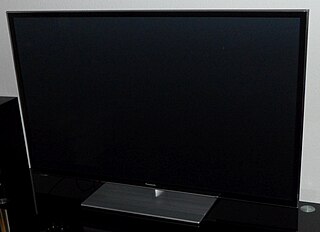
A plasma display panel (PDP) is a type of flat-panel display that uses small cells containing plasma: ionized gas that responds to electric fields. Plasma televisions were the first large flat-panel displays to be released to the public.

A Bayer filter mosaic is a color filter array (CFA) for arranging RGB color filters on a square grid of photosensors. Its particular arrangement of color filters is used in most single-chip digital image sensors used in digital cameras, and camcorders to create a color image. The filter pattern is half green, one quarter red and one quarter blue, hence is also called BGGR, RGBG, GRBG, or RGGB.
A field-emission display (FED) is a flat panel display technology that uses large-area field electron emission sources to provide electrons that strike colored phosphor to produce a color image. In a general sense, an FED consists of a matrix of cathode ray tubes, each tube producing a single sub-pixel, grouped in threes to form red-green-blue (RGB) pixels. FEDs combine the advantages of CRTs, namely their high contrast levels and very fast response times, with the packaging advantages of LCD and other flat-panel technologies. They also offer the possibility of requiring less power, about half that of an LCD system. FEDs can also be made transparent.
A thin-film-transistor liquid-crystal display is a type of liquid-crystal display that uses thin-film-transistor technology to improve image qualities such as addressability and contrast. A TFT LCD is an active matrix LCD, in contrast to passive matrix LCDs or simple, direct-driven LCDs with a few segments.

In digital imaging, a color filter array (CFA), or color filter mosaic (CFM), is a mosaic of tiny color filters placed over the pixel sensors of an image sensor to capture color information.

Large-screen television technology developed rapidly in the late 1990s and 2000s. Prior to the development of thin-screen technologies, rear-projection television was standard for larger displays, and jumbotron, a non-projection video display technology, was used at stadiums and concerts. Various thin-screen technologies are being developed, but only liquid crystal display (LCD), plasma display (PDP) and Digital Light Processing (DLP) have been publicly released. Recent technologies like organic light-emitting diode (OLED) as well as not-yet-released technologies like surface-conduction electron-emitter display (SED) or field emission display (FED) are in development to supersede earlier flat-screen technologies in picture quality.
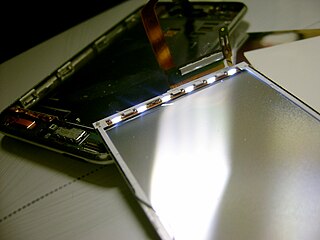
An LED-backlit LCD is a liquid-crystal display that uses LEDs for backlighting instead of traditional cold cathode fluorescent (CCFL) backlighting. LED-backlit displays use the same TFT LCD technologies as CCFL-backlit LCDs, but offer a variety of advantages over them.
PenTile matrix is a family of patented subpixel matrix schemes used in electronic device displays. PenTile is a trademark of Samsung. PenTile matrices are used in AMOLED and LCD displays.

4K resolution refers to a horizontal display resolution of approximately 4,000 pixels. Digital television and digital cinematography commonly use several different 4K resolutions. In television and consumer media, 3840 × 2160 with a 16:9 aspect ratio is the dominant 4K standard, whereas the movie projection industry uses 4096 × 2160.

The Sony Ericsson Xperia ray (ST18i) is an Android smartphone from Sony Ericsson. It was unveiled on 22 June 2011 in Singapore during CommunicAsia 2011. It was announced that the Xperia ray would be released globally in select countries from Q3 2011.
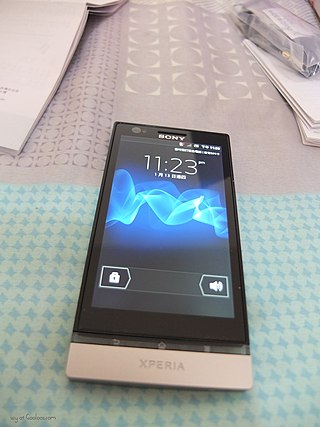
The Sony Xperia P is an Android smartphone produced by Sony that sits above the Xperia U and below the Xperia S. It was announced at Mobile World Congress 2012 alongside the Xperia U and Xperia S.

A see-through display or transparent display is an electronic display that allows the user to see what is shown on the screen while still being able to see through it. The main applications of this type of display are in head-up displays, augmented reality systems, digital signage, and general large-scale spatial light modulation. They should be distinguished from image-combination systems which achieve visually similar effects by optically combining multiple images in the field of view. Transparent displays embed the active matrix of the display in the field of view, which generally allows them to be more compact than combination-based systems.
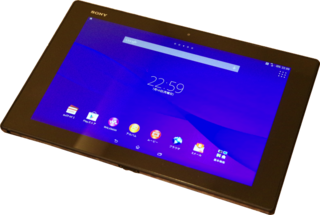
The Sony Xperia Z2 Tablet is a touchscreen Android tablet manufactured and designed by Sony. Like its predecessor, the Xperia Z2 tablet features a 10.1 inch screen and is water and dustproof with a rating of IP55 and IP58. The tablet is the lightest and thinnest 10.1-inch tablet, weighing at 1 pound and is 0.25 inches (6.4 mm) thick, the Z2 Tablet features the Snapdragon 801 processor, Sony's Triluminos display and HDR video recording. Unveiled alongside the Sony Xperia Z2 during the 2014 Mobile World Congress in Barcelona, Spain, on February 24, it was first released on March 26, 2014 in the United Kingdom. On July 3, 2014, Sony launched its Xperia Z2 Tablet in India. On July 27, 2014 Sony released the Z2 Tablet in the US on Verizon.

The Sony Xperia XZs is an Android smartphone manufactured and marketed by Sony. Part of the Xperia X series, the device was announced to the public along with the Xperia XZ Premium at the annual Mobile World Congress last February 2017.
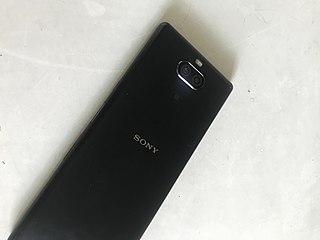
The Sony Xperia 10 and Sony Xperia 10 Plus are Android smartphones marketed and manufactured by Sony. Part of Sony's midrange Xperia series, they were unveiled at the annual Mobile World Congress event on February 25, 2019 alongside the Xperia L3 and Xperia 1.
The Sony Xperia L3 is an Android smartphone marketed and manufactured by Sony. Part of Sony's low-end Xperia series, it was unveiled at the annual Mobile World Congress event on February 25, 2019 alongside the Xperia 10, Xperia 10 Plus and Xperia 1.
The Sony Xperia 8 is an Android smartphone marketed and manufactured by Sony. Part of Sony's midrange Xperia series, it was unveiled on October 7, 2019 as a Japan-exclusive device.
References
- ↑ Reguera, Dany Moran (2012-02-27). "Introducing WhiteMagic™ – the technology in Xperia™ P". developer.sonymobile.com. Archived from the original on 2016-12-29. Retrieved 2019-08-27.
{{cite web}}: CS1 maint: unfit URL (link) - ↑ "WhiteMagic顯示技術". DIGITIMES科技網 (in Chinese). 2018-11-23. Retrieved 2019-08-27.
- ↑ Humphries, Matthew (2012-11-02). "Japan Display demos WhiteMagic and Pixel Eyes display tech". Geek.com. Retrieved 2019-08-27.
- ↑ Klug, Brian (2012-02-26). "Sony Announces Xperia P and U, joining Xperia S NXT Series". AnandTech. Retrieved 2019-08-27.